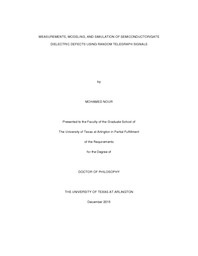
ATTENTION: The works hosted here are being migrated to a new repository that will consolidate resources, improve discoverability, and better show UTA's research impact on the global community. We will update authors as the migration progresses. Please see MavMatrix for more information.
Show simple item record
| dc.contributor.author | Nour, Mohamed Assad | |
| dc.date.accessioned | 2016-02-24T20:24:04Z | |
| dc.date.available | 2016-02-24T20:24:04Z | |
| dc.date.issued | 2015 | |
| dc.date.submitted | January 2015 | |
| dc.identifier.other | DISS-13368 | |
| dc.identifier.uri | http://hdl.handle.net/10106/25596 | |
| dc.description.abstract | Constructing an effective statistical model and a simulation tool that can predict the phenomenon of random telegraph signals (RTS) is the objective of this work. The continuous scaling down of metal oxide – semiconductor field effect transistors (MOSFETs) makes charging/discharging traps(s) located at the silicon/silicon dioxide interface or deep in the oxide bulk by mobile charge(s) a more pronounced problem for both analog and digital applications. The intent of this work is to develop an RTS statistical model and a simulation tool based on first principles and supported by extensive experimental data. The newly developed RTS statistical model and its simulation tool should be able to replicate and predict the RTS in time and frequency domains. First, room temperature RTS measurements are performed which provide limited information about the trap. They yield the extraction of some trap and RTS characteristics such as average capture and emission times associated with RTS traces, trap position in the oxide with respect to the Si/SiO2 interface and along the channel with respect to the source, capture cross section, and trap energies in the Si and SiO2 band – gaps. Variable temperature measurements, on the other hand, yield much more valuable information. Variable temperature RTS measurements from room temperature down to 80 K were performed, with the MOSFET biased from threshold voltage to strong inversion, in the linear and saturation regions. Variable temperature RTS measurements yield the extraction of trap characteristics such as capture cross – section prefactor, capture and emission activation energies, change in entropy and enthalpy, and relaxation energy associated with a trap from which the nature and origin of a defect center can be identified. The newly developed Random Telegraph Signals Simulation (RTSSIM) is based on several physical principles and mechanisms e.g. (1) capturing and emitting a mobile charge from and to the channel is governed by phonon- assisted- tunneling, (2) traps only within a few kBT of the Fermi energy level are considered electrically active, (3) trap density is taken as U – shaped in energy in the silicon band-gap, (4) device scalability is accounted for, (5) and temperature dependence of all parameters is considered. RTSSIM reconstructs the RTS traces in time domain from which the power spectral density (PSD) is evaluated. If there is 20 or more active traps, RTSSIM evaluates the PSD from the superposition of the RTS spectra. RTSSIM extracts RTS and trap characteristics from the simulated RTS data and outputs them to MS Excel files for further analyses and study.The novelty of this work is: (1) it is the first time quantum trap states have been accurately assigned to each switching level in a complex RTS corresponding to dependently and independently interacting traps, (2) new physics-based measurement-driven model and simulation tool has been developed for RTS phenomenon in a MOSFET, (3) and it is the first time a species in SiO2 responsible for RTS has been identified through time-domain measurements and extensive analysis using four trap characteristics at the same time. | |
| dc.description.sponsorship | Çelik-butler, Zeynep | |
| dc.language.iso | en | |
| dc.publisher | Electrical Engineering | |
| dc.title | Measurements, Modeling, And Simulation Of Semiconductor/gate Dielectric Defects Using Random Telegraph Signals | |
| dc.type | Ph.D. | |
| dc.contributor.committeeChair | Çelik-butler, Zeynep | |
| dc.degree.department | Electrical Engineering | |
| dc.degree.discipline | Electrical Engineering | |
| dc.degree.grantor | University of Texas at Arlington | |
| dc.degree.level | doctoral | |
| dc.degree.name | Ph.D. | |
Files in this item
- Name:
- Nour_uta_2502D_13368.pdf
- Size:
- 4.970Mb
- Format:
- PDF
This item appears in the following Collection(s)
Show simple item record


